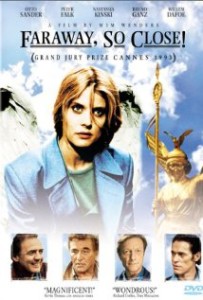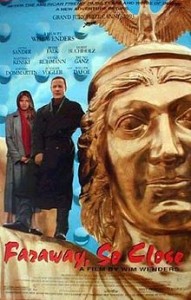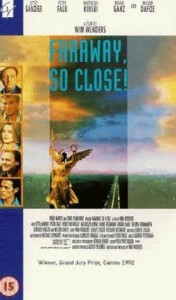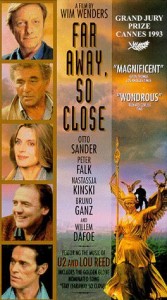Faraway, So Close! [In Weiter Ferne, so Nah!] **** (1993, Bruno Ganz, Otto Sander, Solveig Dommartin, Peter Falk, Nastassja Kinski) – Classic Movie Review 2323
In the fascinating and undervalued 1993 sequel to his 1987 international arthouse success Wings of Desire, co-writer-director Wim Wenders revisits a totally changed Berlin as he reunites with his stars Bruno Ganz and Otto Sander, who reprise their roles as angels Damiel and Cassiel visiting earth, as well as Solveig Dommartin as the trapeze artist and Peter Falk as Der Filmstar. In weiter Ferne, so nah! won the Grand Prix du Jury and was nominated for the Palme d’Or at the 1993 Cannes Film Festival.
Again, as before, it is filmed in black and white and colour, but this time by cinematographer Jürgen Jürges. The screenplay is by Wenders, Richard Reitinger and Ulrich Zieger. Even though Wenders cut nearly an hour out of the film to get it to its release running time, at 144 minutes it plays at a daunting epic length.
Wenders once again imagines and explores an intelligently playful fantasy world where a group of angels roam the streets of the German capital of Berlin, lurking unseen in the subways, alleys and remotest corners. Cassiel (Otto Sander) and Raphaela (Nastassja Kinski) are chief among the angels who are observing the earth’s inhabitants, listening to their thoughts but forbidden to alter their destinies. Cassiel examines the human condition and recognises how lost people have become, but he grows despondent over his fate as an observer.
He again meets his former angel friend Damiel (Bruno Ganz), now a mortal pizza maker living with his trapeze artist wife Marion (Solveig Dommartin), a single mother and her daughter, an elderly chauffeur, a private eye, a shady businessman (Horst Buchholz) and a gangster.
Cassiel chooses to become mortal to save the single mother’s little girl when she falls from a balcony. Cassiel chooses the human name of Karl Engel (engel being German for angel). But Cassiel’s time on earth is being closely watched over by Emit Flesti, or Time Itself (Willem Dafoe), who can enter both worlds.
Added to all these intriguing characters are Peter Falk returning from the original in the role of Der Filmstar, Lou Reed (as himself), The Magnificent Seven‘s Horst Buchholz (as Tony Baker) and former Soviet leader Mikhail Gorbachev (as Als Gast)! Naturally it features the music of Lou Reed, as well as U2. The Original Motion Picture Soundtrack was released on 25 January 1994. The soundtrack mix of the U2 songs Stay (Faraway, So Close!) and The Wanderer are an augmentation of the July 1993 Zooropa release.
Distributed by Sony, the international 140-minute American release is a substantially re-edited version of the original film that won the Grand Jury Prize at the 1993 Cannes Film Festival. Unsurprisingly, it took a paltry $800,000, with the obscure and arty-sounding English-language title hardly a help at the box office.
Nevertheless, it is a film-making tour-de-force with bravura scene following bravura scene from the astonishing opening helicopter shot of Cassiel standing on the statue of the Angel of Victory overlooking the new Berlin. Wenders manages to control a long movie on a wide canvas, while keeping both the central story clear and appealing and the film’s message direct, simple and sweet.
Speaking back then, Wenders is pessimistic about the current state of the world (‘people haven’t conquered the world, the world has conquered them’) but optimistic about the power for good in human beings. He says he filmed Faraway, So Close! as an antidote to being refused permission to shoot Wings of Desire in East Berlin. So this time he shot it almost entirely on startling locations there, exploring the other side of the city he didn’t know back in the Eighties.
Gorbachev appears because his secretary was a great admirer of Wenders’ movies and talked him into giving up a couple of hours to do the cameo while on a trip to Germany.
© Derek Winnert 2015 Classic Movie Review 2323
Check out more reviews on http://derekwinnert.com






